#phylum round 1
Text
Phylum Round 1
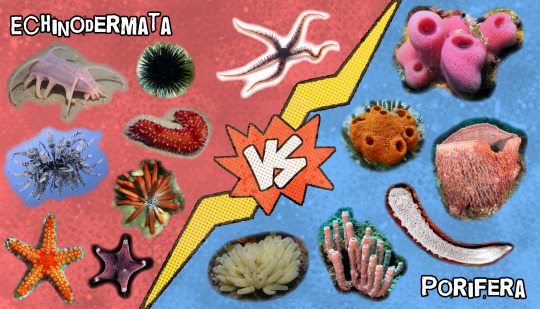
Echinodermata: Sea urchins, sea stars, sea cucumbers, brittle stars, and feather stars. This widespread phylum can be found near every continent, including Antarctica, where they are particularly dominant. They are distinctive for their radially symmetrical body and skeleton located between the outer skin and inner body cavity. They move by hydraulic power using a "water vascular system" which pumps water throughout their body. Hundreds of tube feet extend and retract using this system, allowing them to crawl on the seafloor. These organisms play important roles in the food chain of their habitats, like sea urchins grazing in kelp forests.
Porifera: Sponges. One of the oldest forms of animal life on Earth, Porifera represents an evolutionary transition to multicellular life. Their bodies are made up many individual cells, rather than having true tissues, but these cells work together as one organism. By beating specialized flagella (whip-like structures), Sponges create a water current through their many pores, so they may filter feed while living on the seafloor. Various species have developed unique adaptations, such as an internal skeleton of spikes, symbiosis with photosynthesizers, or potent toxins to ward off predators. Many Sponges produce unusual chemical compounds that may be useful to medical research.
#echinodermata#porifera#animal bracket#tumblr bracket#bracket tournament#poll bracket#phylum round 1#phylum
438 notes
·
View notes
Text
Phylum Round 1
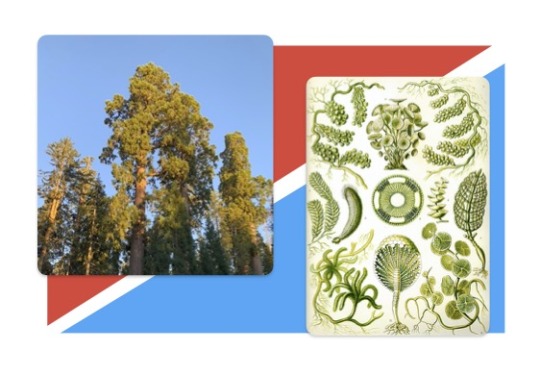
Pine Trees vs A Different Type of Green Algae!
Pinophyta or Coniferophyta (conifers): pines, firs, spruces, sequoias, cedars, junipers, larches, cypresses, kauri, yews — if it has cones and needles rather than leaves and fruit, it’s probably a conifer! (Other gymnosperms — plants that bear seeds but not fruit — are the cycads, the ginkgo-like plants, and the gnetophytes.) Most are trees, but some are shrubs; conifers are especially prominent in boreal forests near the Arctic Circle, which store 1/3 of Earth's terrestrial carbon.
Chlorophyta (big category of green algae less closely related to land plants): I wasn't sure I was going to have anything interesting to say about these guys, but I was so wrong! With over 4,000 known species, chlorophytes are extremely diverse. Most live in fresh water, but some live in the ocean or on land. Some live in extreme environments, like deep sea hydrothermal vents, hypersaline lakes, deserts, and the arctic. Some have mutualistic relationships with animals like mollusks or sponges or cnidarians, and others have mutualistic relationships with fungi, forming lichen. While plants are known for being autotrophs (creating their own food), some chlorophytes are heterotrophs -- they get their nutrition from other organisms, either as parasites or otherwise. Some are pathogens.
#Pinophyta#Chlorophyta#I am deeply regretting putting these two against each other in round one#plant taxonomy showdown#battle of the plants#phylum round 1#phylum#plant bracket#tumblr bracket#bracket tournament#poll bracket
159 notes
·
View notes
Text
Spirochaetota vs. Abditibacteriota
Spirochaetota propaganda here
Abditibacteriota propaganda here
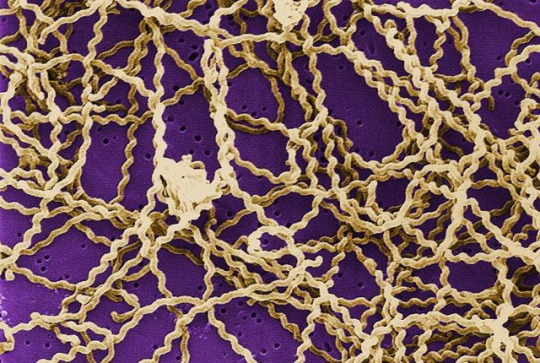
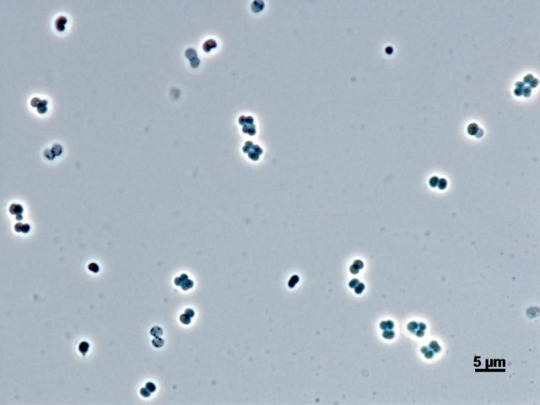
86 notes
·
View notes
Text
Favourite animals poll! Round 1
Beginning with bigger Linnaeic categories (and/or clades if is is necessary) and narrowing down per round. First, we will start with the top-level phylums.
#is the plural phylums or phyla?#anyhow#favourite animals poll#favourite anima#ls#animals#poll#polls#animal polls#clades#round 1#rounds#comb jellies#sponges
1 note
·
View note
Note
Hey, thanks so much for recommending Nope! It's now one of my new all-time favorite movies!
To celebrate, I elected to stat up the star of the film in Savage Worlds.
(Spoilers for those who have yet to see it.)
@Jean Jacket
Description:
Kingdom: Animalia.
Phylum: Nubaria, “of the clouds.”
Class: Oblatozoa, “oblate shaped animal.”
Order: Suctoforamina, “window of suction.”
Family: Verispellidae, “shapeshifter.”
Genus: Occulonimbus, “dark cloud”
Species: Occulonimbus edoequus, “Dark Cloud Stallion Eater”
Immense. Awe-inspiring. Fast. Territorial. Hungry. The animal known as Jean Jacket is all of these things and more.
Don't look at it.
Attributes: Agility d12, Smarts d8 (A), Spirit d8, Strength d12+12, Vigor d12
Skills: Athletics d10, Notice d12, Stealth d12
Pace: -; Parry: 2; Toughness: 20
Special Abilities:
All-Around Vision: Jean Jacket's method of sight is unknown, but it can see in all directions, even “behind” it.
Cloud Cover: By expelling a gaseous vapor, Jean Jacket can perfectly disguise itself as a cloud, recognizable only in that it hovers perfectly still as it does so. Rolls to Notice it in this form suffer a -4 penalty as long as it stays still.
Crush: A single attack made against all of its captured prey. Automatically hits. Range 0, Strength in damage.
Anti-Electrical Field: For some unknown reason, though speculated to be electromagnetism related to its ability to fly, Jean Jacket's very presence powers down all electronic devices within 400 meters (200”). They whir back to life the instant the monster leaves the area.
Fear: Jean Jacket's sheer size and speed is horrifying, even moreso when it is unfurled. All who see it must make a Spirit roll to avoid being Frightened. The roll is made at -2 if it recently ate, as the screams of its victims are amplified and carry well on the wind.
Flight: Capable of chasing down a riding horse, Jean Jacket has a flying speed of 90” (60 MPH). -1 penalty to hit. It is always able to hover.
Gas Bag: The trouble of harming Jean Jacket stems not from armor, but from a sheer lack of anything to harm. Called Shots do no extra damage, but explosive attacks deal double damage.
Size 12 (Gargantuan): Jean Jacket measures 110 meters in diameter and 20 meters thick at its widest point while hunting, but its form, while large and imposing, is mostly hot air. +6 to hit, but only Heavy Weapons can hurt it. (Average of +5 combined with Flight.)
Spit: Athletics roll to hit. d4-d10 damage, depending on size of the object. Range is 12/24/48. The indigestible bits of Jean Jacket's meals are often shot back down at the ground at high enough velocities to embed themselves in flesh and wood, but rarely do enough damage to kill.
Swallow Whole: All those devoured by the massive, flying predator's mouth find themselves trapped in a hot, suffocating, claustrophobic gut. At the end of each turn, any creature inside must make a Vigor roll at -2 to avoid taking a wound from the crushing and acid. The roll is instead made at +4 if Jean Jacket's stomach is blocked by something.
Vacuum: Jean Jacket's primary method of capturing prey. Everyone within a medium blast template (if directly above) or in a cone template (if coming at an angle) must make a Strength check at -4 to avoid being inhaled and immediately Swallowed Whole. Creatures that are Large make the roll at -2 and Huge make the roll with no penalty. Gargantuan creatures are immune to this suction. If Jean Jacket is Shaken or Wounded in the same round that it vacuumed up a creature, that creature is automatically spat back out.
(For those who don't play Savage Worlds, Jean Jacket is a bit of a glass cannon for its size, as well as a one-trick pony, but anything it vacuums up is going to be dead in a round or two, tops. I wasn't sure how to balance the speed since horses are statted much slower for tactical play, so I went with the IRL top speed of 55 MPH for reference. To balance against the horse stats in the core rules, reduce the flight speed's to 12-18 tabletop inches (24-36 yards/meters per turn) and allow it to "run.")
I've never played and can still tell how well this is adapted!
105 notes
·
View notes
Text
WAR AND HATE ON PLANET EARTH
WELCOME TO THE PHYLUM PHIGHT
A BRACKET WHERE THE 37 KNOWN PHYLA OF ANIMALS (extant and otherwise) WILL BATTLE TO THE DEATH. ONLY ONE MAY BE CROWNED CHAMPION-- AND ASCEND TO THE STATUS OF KINGDOM (i have this power)
WHO WILL IT BE? THE CHORDATES, CONTAINING EVERY KNOWN VERTEBRATE INCLUDING YOU AND ME? I FEEL LIKE THAT'S A BIAS. MAYBE THE HUMBLE TARDIGRADES, THE INTERNET'S FAVOURITE EXTREMOPHILES? OR WILL IT BE THE PENIS WORMS? I FEEL LIKE IT'S GONNA BE THE PENIS WORMS.
TOURNAMENT STRUCTURE:

ok ditching allcaps now <3
round 0
preliminary face-off between the odd phellas. lasting one (1) week to give bitches time to mobilise
protoarticulata VS rhombozoa
2. phoronida VS vetulicolia
3. petalonamae VS xenacoelomorpha
4. porifera VS rotifera
5. platyhelminthes VS saccorhytida
round 1
all round 1 poll-batches will last one (1) day because dear god there are so many of them. there will however be a cooldown of like, a couple days or something between batches because i am but one man
batch 1 - BATCH TO THE DEATH
6. priapulida VS winner of 1
7. annelida VS chaetognatha
8. trilobozoa VS micrognathozoa
9. bryozoa VS lorcifera
batch 2 - THE BATCHENING
10. tardigrada VS winner of 2
11. brachiopoda VS gastrotricha
12. mollusca VS winner of 3
13. nematomorpha VS gnathostomulida

batch 3 - BATCHETFIELD HIGH
14. chordata VS winner of 4
15. archaecyatha VS cycliophora
16. nematoda VS nemertea
17. ctenophora VS kinohyncha
batch 4 - I HAVE RUN OUT OF BATCH PUNS
18. arthropoda VS winner of 5
19. agmata VS entoprocta
20. cnidaria VS onychophora
21. echinodermata VS hemichordata
round three wait and see!!!
this bracket doesn't require nominations, as the candidates are already set out all nicey for us by Science. how cool of them. Now we make them beat each other senseless for our sick amusement :)
HOWEVER please send asks, suggest representative species or images to make sure we see them at their best, send propaganda/fun facts youd like the filthy electorate to know before they condemn your fav to the deepest most basal pits of taxonomic superhell. lets all get to know the Beasts together. Before we make them fight to the death.
-mod riz (he/him)

ROUND 0 START: APRIL 10TH
#phylum phight#phylum-phight-tourney#tumblr tournament#taxonomy#tumblr polls#tournament#poll tournament#animal tournament#biology#cnidaria#bryozoa#chordata#arthropod#echinoderm#molluscs
32 notes
·
View notes
Text
Spec Evo Project: Maya 1b
Part 1: The Sophonts
Some background Info:
My spec evo world Maya 1b or Halahal, it's a planet a bit smaller than earth but with a much higher eccentricity and axial tilt than ours that leads to a relatively cold, dry world with extreme seasonal shifts, this project is about exploring how the biology of the creatures and subsequently the culture of the sophont species would work in such an environment
Enough about the world, here we go

These guys are my main sophont species, one that I've tentatively named "Butterfly Hawks", part of the Artiopoditheria (transl. Even-Legged Beast) phylum that contains creatures having 12,6 or 2 legs
The Butterfly-Hawks are a group of dodecapods that have developed powered flight and hunt in packs among the grassy plains of their planet and are starting to display the first signs of sapience
Alright onto anatomy
1) Eyestalks
They possess one pair of retractable eyestalks on the anterior part of the head covered in "fuzz" that serve the fuction of both mechanoreceptors and to protect the eyes
This feature grants them a wide range of vision, a characteristic of their phylum
The head is a bit smaller than pictured here, the fuzz accounts for about 40℅ of its size
2) Antennae
Instead of an ear, they have four feathery antennae-like structures present near the eye stalks
These mainly serve the function of mechanoreceptors, picking up vibrations, auditory & pheromone signals and could be moved around and adjusted like the pinnae of cats or dogs
The antennae are also moved around to help communicate with other members of the species
They are mainly dark in colour covered with spot like designs to facilitate communication by making the it easier to identify and read the movements
3) Feeding Appendages
All Artiopods possess a pair of feeding appendages to capture and ensnare prey and which also often aid in defense often situated above or surrounding the opening to the proboscis
The Butterfly-Hawks possess quite a robust pair of feeding appendages with long inward curved spikes(not pictured here) to quickly kill and tear apart prey
As past of the body it is also covered with picnofibres to help insulate the body
4) Forewings
The first pair of limbs in hexapods is modified to form the first wing in Butterfly-Hawks and their relatives
These are the secondary wings and are slightly rounded to help steer and maneuver the body while flying
Each wing also possesses three fingers
Thus, when not flying, the fore wings are also used to grasp and to manipulate tools
The fore wings surround the opening to the proboscis and also sometimes help in further breaking down food to "swallow"
5) Midwings
The midwings are formed by the fusion of the 2nd, 3rd & the 4th pair of limbs in the dodecapods, three fingers curl inwards to form the wing and the other three are used for griping and standing when not in flight
These are the primary set of wings, broad, muscular and used to generate flight
The Butterfly-Hawks have an average wingspan of about 7 feet
These wings possess an splotchy pattern that is dark at the extremities and yellow or whitish near the centre
This splotchy pattern helps members of a pack to identify one another like seen in the multicolored coats of Painted dogs, and like human fingerprints the pattern on each Butterfly-Hawk is specific to that individual only
6) Hindwings
The hindwings are formed by fusion of the 5th & 6th pair of limbs in dodecapods
Longer and pointer in shape than the forewings this set of secondary wings play a greater part in balancing and steering analogous to the tails of earth birds
While similar in function to bird tails, they have a greater range of mobility and could be unfurled and adjusted to make flight easier
The hindwings are held up in most situations while flying or walking as the large midwings provide a stable enough surface but the could be extended down to provide extra stability to the body while perching or walking
7) Spiracles
Butterfly-Hawks like other artiopods, possess two pairs of spiracles in the upper side of their body, one pair near the forewings and the other near the hindwings
Work alternatively to inhale and exhale air
As such the respiratory system of all Artiopods is distinct from the digestive system making it a more efficient method of respiration than the one humans possess
Aaaaaand we're done for now
This was a very general overview of the physiology of the Butterfly-Hawks, the next part I'll probably upload will shown the other major phylum on this planet, the Perissopoditheria (or the Odd-Legged Beast) in the meantime enjoy this Butterfly-Hawk sitting and thanks for reading

#spec evo#speculative biology#speculative evolution#speculative anatomy#original species#maya1b#alien art#creature design
10 notes
·
View notes
Photo


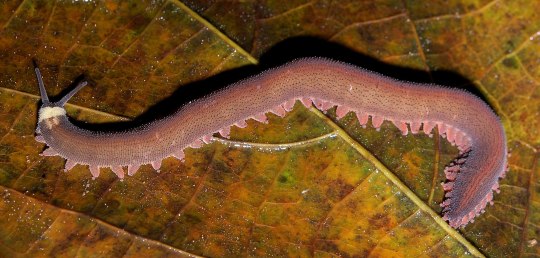
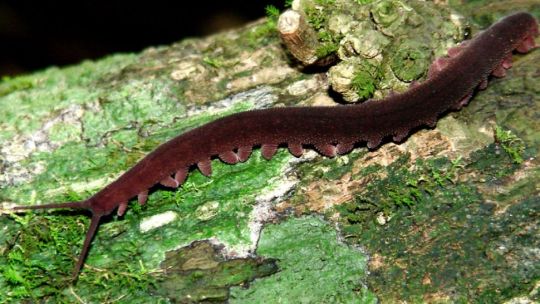
A Soft Spot for Velvet Worms
requested by @skywalkerlizard
Found all over the world, velvet worms are a large group of invertebrates in the phylum Onychophora, consisting of about 180 species. Despite their lack of vertebrae and their close resemblance to insects, velvet worms are not classed with arthropods. Their evolutionary lineage dates all the way back to the Cambrian era, where early fossils closely resemble the species we can observe today. Many scientists now group velvet worms, arthropods, and another group of invertebrates known as tardigrades together in one ‘superphylum’ known as panarthropoda, but for most cladistic purposes velvet worms are the sole members of their group.
Because of their long evolutionary history and their global distribution, velvet worms can vary widely in appearance. Species can range from 0.5 to 20 cm long and come in a variety of colors. However, there are several characteristics that unite Onychophora as a group. All velvet worms have long bodies with forward antennae and stubby feet known as oncopods-- though the number of feet varies from species to species. Each of these feet have retractable chitin claws that give the group its name. The body and feet are covered with small scaly bumps called papillae which facilitates breathing and moisture retention, acts as a fine-tuned sensor for motion, and which give Onychophora their velvet-y appearance.
Although they have mouths, velvet worms breathe mostly through their skin. The way that their skin and muscles are layered makes oxygen transfer easy and allows velvet worms to be extremely flexible. However, the cost of such structure is that velvet worms require moist environments, lest they dry out; as such, Onychophora is restricted to tropical habitats. They are also photophobic, and will shy away from bright lights. As such, velvet worms tend to live under leaf litter or in rotting logs, where food is abundant, though some species have been found in grasslands and caves. While fossils have been found in North America, Europe, and Central Asia, extant species today are located mostly in the southern hemisphere; specifically Central and South America, southern Africa, southeast Asia, and Australia.
Because of their photosensitivity, velvet worms are nocturnal. This lends itself well to their preferred method of hunting: ambush. Onychophora can produce a powerful adhesive slime which they can shoot at and ensnare unsuspecting prey. The type of prey varies based on species and location, but generally velvet worms will prey on insects, snails, and worms. They are restricted only by size, as the larger the prey the more slime is needed to subdue. Once a potential meal is secured, velvet worms will inject it with salivary secretions that liquefy their prey and make it easier to digest. The process can take several hours, after which an individual may not feed again for anywhere from 1-4 weeks. Velvet worms are vunurable as prey to snakes, birds, and larger insects like centipedes and spiders.
Like many invertebrates, velvet worms are relatively solitary. Breeding can occur year-round, as velvet worms are rare enough that seasonal encounters are unlikely. Due to the size of the phylum, it is easy to find examples of almost every type of reproduction; egg-laying, egg live-bearing, live-birth, and asexual reproduction. The last mode, asexual reproduction, is the most rare as it has only been observed in one species. For species that reproduce sexually, methods and courtship rituals can vary widely, as does the number of offspring produced. Generally speaking, the length of time it takes to produce offspring is between 6 months- 1 year, although this too can vary from species to species. Females have been known to reach sexual maturity at about a year and a half, and individuals generally don’t live more than a few years.
Conservation status: Many species of velvet worms are only found in one locality; as such, it is difficult to estimate how threatened they are. However, some particularly vulnerable species have been assessed as Endangered or Critically Endangered; these species include the Blind Velvet Worm (Tasmanipatus anophthalmus) and the Lion’s Hill Velvet Worm (Peripatopsis leonina). Their main threats come from habitat destruction and fragmentation.
Photos
Andras Keszei
Piotr Naskrecki
Geoff Gallice (via Wikipedia)
Olivera et al (via Zoologischer Anzeiger)
#velvet worms#Onychophora#invertebrates#tropical fauna#tropical invertebrates#tropical forests#tropical forest invertebrates#tropical rainforests#tropical rainforest invertebrates#terrestrial invertebrates#grasslands#grassland invertebrates#caves#cave invertebrates#wetlands#wetland invertebrates#central america#south america#africa#south africa#asia#southeast asia#australia#oceania#animal facts#biology#zoology
83 notes
·
View notes
Text
Phylum Round 1

Onychophora: Velvet Worms. This is the only phylum containing exclusively terrestrial members, although their ancestors can be traced back to the Cambrian shallow oceans. Onychophorans are ambush predators, moving with slow smooth steps to creep up on their prey. They have unique mucus glands on either side of their face which can spray jets of sticky slime, which effectively immobilizes their prey. Onychophorans have relatively complex brains, and some even live in social "packs" that live and hunt together. Many species in this phylum are ecologically vulnerable, threatened, or endangered.
Platyhelminthes: Flatworms. This phylum includes both colorful free-living members and more modest parasitic members. Free-living worms can be found in marine, freshwater, and even terrestrial environments. All flatworms are, of course, dorsoventrally flattened so their whole bodies can access oxygen from the outside, as they have no specialized circulatory system. Some flatworms are of interest to research in tissue regeneration, as they have the remarkable ability to completely regenerate a new body from a cut piece. Many classes within Platyhelminthes are exclusively parasitic, including flukes, tapeworms, schistosomes, and others. Most flatworms are hermaphroditic, and some larger marine species practice a ritual known as "penis fencing" to determine which worm's eggs will be fertilized.
#worm on worm violence#the wikipedia article on onychophora is unusually detailed and thorough which is delightful#cw parasites#onychophora#platyhelminthes#animal bracket#tumblr bracket#bracket tournament#poll bracket#phylum round 1#phylum
274 notes
·
View notes
Text
Phylum Round 1

The Other Kind of Gymnosperm vs Red Algae
Gnetophyta: I don't really know what's going on with these plants. They're gymnosperms (like pine trees -- seeds yes, flowers no) but there's only 70 species in three genera, and all three genera look pretty different from each other. And I'm not the only one scratching my head here, according to Wikipedia, "Unlike most biological groupings, it is difficult to find many common characteristics between all of the members of the gnetophytes." The phylum includes vines, shrubs, and less commonly trees. Welwitschia mirabilis (shown above) lives in the Namib desert in Africa and can grow up to 4 meters or 13 feet in diameter.
Rhodophyta: Arguably not a plant, sometimes a seaweed (the seaweed used in sushi is a red alga.) Over 7,000 known species. Most live in the ocean. No chloroplasts, but they can be green anyways, or pink or brown or purple or almost black, or of course red. Most red algae are multicellular and can be seen without a microscope, and they mostly reproduce sexually. As with many plants they often have alternation of generations, but may have three stages rather than two. A distinguished member of the phylum is corraline algae, which is essential in forming coral reefs.
#gnetophyta#rhodophyta#battle of the plants#plant taxonomy showdown#phylum round 1#phylum#tumblr bracket#bracket tournament#poll bracket#plant bracket
195 notes
·
View notes
Text
Rhodothermota vs. Campylobacterota
Rhodothermota propaganda here
Campylobacterota propaganda here


67 notes
·
View notes
Text
Animal Crossing Fish - Explained #73
Brought to you by a marine biologist who’s listening to the people...
CLICK HERE FOR THE AC FISH EXPLAINED MASTERPOST!
You voted and I listened. Today we are covering the Octopus because that’s what 6 people wanted to see. (No worries - we will eventually cover all things aquatic in ACNH). So, yes, the octopus. You can dive all day, all night, all week, all year for these things, so, by now, I’m guessing you have caught one before. If not, get out there more.

There are so many different types of octopus in the game, it seems silly to just call this one “octopus” at first glance. But then I remember the largest genus of octopuses is just called “octopus” and I’m like...okay, AC, you’re fine this round. Octopuses in general are an incredible group of animals within the giant phylum of Mollusca, for which we just covered another member last time, the scallop. Of course, octopuses belong in a completely different class than the bivalves called the Cephalopods. These are all your squid and octopuses and all of their relatives we’ve covered, like the extinct Ammonites and the Vampire Squid. They all very squishy with no bones or shells, really, to speak of. The octopus in ACNH is most definitely the California Two-Spot Octopus (Octopus bimaculoides):

Theses guys are native to, that’s right, Californian waters. Octopuses in general are masters of camouflage, able to expertly change not only the color of their skin, but also the texture of it.
Now, let’s really consider the octopus for a moment. It’s pretty amazing how diverse the phylum Mollusca is - you have seemingly brainless bivalves that live pretty sedentary lives in their shells, all the way to these geniuses with eight arms (and yes, they are arms, not tentacles. There’s a difference!) If you really think about it, octopuses are such a great model in showing how intelligence can propagate in living things built very differently than us.
For example, consider that the octopus has 9 “brains” - a central brain that controls the nervous system, but a smaller, nerve cluster in each of its eight arms, allowing the arm to move and act independently and yet all towards the same goals. This separation of the nervous system is alien af to us, who have all of the controls in one place - our heads.
And it’s very hard to measure intelligence fairly among all groups of animals - of course, octopuses have brains that are best suited to their lifestyle as oceanic predators that are themselves soft-bodied and vulnerable prey items. In general, we measure intelligence by an animal’s ability to contextualize, remember, store, retrieve, and combine information and apply it to their situation. Octopuses can do all of those things - they are able to use tools, they can be trained to remember and identify shapes, as well as other great feats of a thinking creature.
Of course, intelligence only goes so far - you gotta have the machinery to use it. Being able to manipulate the world around you, either through using tools or figuring out how something works to obtain your goals or build things is such an important application of intelligence we see in octopuses, parrots, apes, and humans. It’s also why animals like dolphins and crows fall short, as they are not as easily able to manipulate things (although they still do it, just not as gracefully as the rest of us).
The next step is living long enough to pass on what you learned to your offspring, and this is where octopuses fall short. Think about how humans have gotten so far - it’s because when we learn something, we share it with other humans (like I do with these fish explained!) We live long, social lives that allow the passage of knowledge to flow through generations, allowing us to build on top of someone else’s work. Elephants do this, too - the matriarch teaches her children and grandchildren where water will be during drought, among other things. Whales show their calves the migration routes. Etc. It’s all about not inventing the wheel over and over again. But octopuses can’t do this. As smart as they are, most species only live 1 year and die right after their eggs hatch. So, there’s no flow of knowledge in octopus society (I made that up, they’re not that social either).
So, no, we don’t have to worry about an octopus uprising.
And there you have it. Fascinating stuff, no?
#octopus#cephalopod#marine biology#animal crossing#animal crossing new horizons#science in video games#animal crossing fish explained
32 notes
·
View notes
Text
The Best Spell to Use on an Opponent
Wish.
Obviously.
...but let’s say you don’t want to cast a spell that drains XP (3.5), requires a ginormous diamond (3.P), or can make you unable to use magic ever again (5e) and regardless of edition requires you to outthink the DM so as not to get screwed over.
I’ll give you five really good effective options.
#1: FIREBALL
This is a classic for several reasons:
Fire as an invention was (and still is) an incredibly useful tool for constructive, supportive, and destructive purposes. No other energy type provides quite as much utility.
It deals a lot of damage relative to its level.
It has a long range.
The size of its AoE is rather large, if you stop to think about it.
The sphere is the best AoE shape. (”Chain” isn’t an AoE or a shape, it’s a selection of targets within a distance regardless of shape.)
This makes fireball versatile. Sure, there may be more situationally appropriate choices, but if that’s a major concern for you then you probably want to play a Wizard. Wizards* invest in wands of fireball so they can get the versatility without sacrificing their edge (variety). We’re Sorcerers here: be the wand of fireball, save your gold for something more precious.
To cite a fantastic example, in Futurama: Bender’s Game, Bender ends an encounter with a red dragon by using his wand of fireball on the river upon which his party had been canoeing. By doing so, he provides them a wall of steam to conceal their escape. Voila: fireball acting as fog cloud/invisibility/any other sense-impairing spell. Lots of spells can be used in clever ways; fireball happens to be well suited for that task, as I’ve illustrated.
*In 3.x, at least. In 5e, Wizards prepare like Pathfinder!Arcanists, which is like getting to cast like a Sorcerer but being able to switch out your spells known every day. Easy? You bet. Already overpowering for a class that was one of the best classes in the game? Ya betcha!
#2: Many Enchantments and Illusions
We’re talking effective, not necessarily ethical.¹ When Enchantments and Illusions do not outright end/bypass encounters, they tend to set them up for something else to have an arbitrarily easy time doing so.
#3: Shatter
You can break things - like the ground beneath someone’s feet (if only in a small patch) or their weapons or whatever. This is one of the many uses for fireball, but as it has a harder time killing things (and tends to ruin what phat lewt you would otherwise get), it’s not even #2 on this list of “good spells that come to mind.”
#4: (Baleful) Polymorph
5e removed the supremely unethical aspects of this spell by merging it with polymorph and making the duration shorter. By doing so, a PC caster doesn’t risk damning themself to Tartarus for permanently changing someone against their will into an animal of a different phylum and in so doing erasing their minds. On the downside, now there’s not really a way of making most villainous mages from folklore and mythology, either.

(All of the humor from this comment is gone!)
Regardless of duration, though, turning an opponent into a small (but still visible), slow, and harmless creature (like a sloth) is a surefire way of ending a fight, whether or not you squish them. Turning them into something bigger (llama), faster (cat, dog, rabbit), sturdier (turtle), or more dangerous (dog, blue-ringed octopus, viper) is where people go wrong with this.
#5: Temporal Stasis (3.x only)
There are lots and lots of spells which impede movement; these are, in general, good choices. Most of them have some sort of drawback or common resistance.
Not temporal stasis.
Timey-wimey effects are few and far between in D&D because they’re almost always considered too powerful for one reason or another. Time stop doesn’t even work like it should: you can’t do anything DIO does with ZA WARUDO!
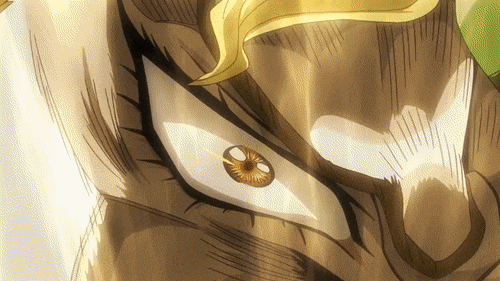
{Time crunchy noises.}
Why? ‘Cuz D&D makes it a way of giving yourself buffs or casting delayed blast fireball a few times and nothing else: in 3.x, you can’t affect other creatures period; in 5e, the spell ends if you try to do so. You can’t simply attack people (coup de grace them, throw knives at them, drop steamrollers on top of them and then pound them into the pavement) - or even move them down flights of stairs repeatedly. ‘Cuz that would be OP for a ninth level spell to do.
(Mind you, sleep is a 1st level spell. The main differences are that there are a few different ways to resist it [which are fairly common] and it has an HD/HP cap. You can still use it to coup de grace most monsters you encounter.)
Since such spells are rare, there’s not really a (Time) subschool or [Time] descriptor to resist and what monsters there are that have specific resistances to such effects are few and far between. (They’re usually high-level creatures themed around time magic [usually preventing time travel] and the resistances are inconsistent because of the lack of codification.)
Thus, you get temporal stasis flying under the radar. For some reason, trapping someone motionless in time (against which there is almost nothing that can resist) is fine and dandy, even if it’s permanent! You can do all of that and it’s only an 8th-level spell!
Now, you might be thinking that you could reproduce such an effect with imprisonment in 5e. You’re probably correct. The thing is, imprisonment in 5e is the equivalent of 3.x’s spell of the same name (the burial option, referencing one of the versions of how Nimue/Viviane/Morgan le Fay trapped Merlin) merged with maze (extradimensional labyrinth option; the other “hedged prison” descriptions also include versions of the Merlin myth) and binding (all of the other options). Of the three, it works most like binding outside of the general options - specifically the casting time.
In 3.x, imprisonment, maze, and temporal stasis don’t take a minute to cast; they only take a standard action (equivalent to an action).
That means you can use them in combat without much problem.
Imprisonment (3.5 version) includes temporal stasis in its effect. You might think that’s a good thing, but it’s not. Why would I waste one of my precious 9th-level spell slots (let alone a supremely rare 9th-level spell known) on a spell I could replicate with a spell one level lower (temporal stasis) and move earth (a 6th-level spell)? Yeah, that’s two spell slots, but y’know what I can use a 9th-level spell slot for? Wish. Metamagic. A lot of really useful spells, less situational spells. Za. Freakin’. Warudo. On top of all of that, there are ways to resist Abjuration effects; they aren’t common, but they exist.
Maze has the spell slot problem, plus it’s fairly easy to escape one (DC 20 Int check once per round or just wait 10 minutes) and not only are there ways of resisting both Conjuration effects in general and (Teleportation) effects specifically, but they are also more common than either of the other two options. (With two minor adjustments, Kobold Press made a “lesser” version available four spell levels earlier.)
Temporal stasis, by contrast, is a Transmutation effect. That school happens to be overly broad, so there aren’t many things with blanket resistances to it. There are plenty of things which resist (or are outright immune to) polymorphing and similar, but not time magic and not the Transmutation school. It’s main drawback is that both freedom and dispel magic can end it and these are listed as options, not as the only things which can do so. It also has a costly material component (5,000 gp of gem dust from diamonds, emeralds, rubies, and sapphires), whereas the other two do not. At 16th level, that’s a small price to pay for something that won’t have easy resistances. (Mind you, all three are affected by Spell Resistance, so it’s not like any of these are assured victory.)
Still, you want to put a villain out for good without killing them? This is how you do it. I’m not sure it’s any more ethical than straight-up murder, but in theory you could end it before eternity passes them by.
¹ I kinda wanna talk about how the typical approach to the subject of ethical vs. unethical casting (especially from semi- or non-casters) is the height of hypocrisy. Not entirely, though, but that’s likely the anxiety.
21 notes
·
View notes
Text
Happy Ctenophore Day!
by Tim Pearce
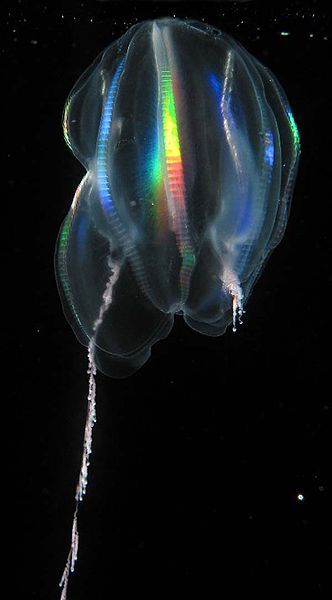
Ctenophore, Mertensia ovum
Most people have heard of 6 to 10 of the 30 modern animal phyla. (A phylum is a major group of animals). In fact, most of us have (intentionally) eaten at least 3 phyla: Chordata (including vertebrates), Arthropoda (including shrimp), and Mollusca (including clams and snails). The adventurous among us might have (intentionally) eaten three additional phyla: Annelida (including earthworms), Cnidaria (including jellyfish), and Echinodermata (including sea urchin [as roe] and sea cucumbers). Beyond those 6 phyla, some of us might have heard of parasitic or pest organisms such as Nematoda (round worms) and Platyhelminthes (flat worms), or other interesting phyla such as Porifera (sponges) and Tardigrada (water bears), but most phyla are unknown to most people.
Behold the phylum Ctenophora or comb jellies, which live in ocean water around the world. Their jelly bodies somewhat resemble jellyfish but ctenophores lack stinging cells. They have 8 rows of cilia that look like combs, hence the name (ctene means comb and phora means bearing). Their two longer, retractable tentacles are fringed with smaller tentacles covered with sticky cells that capture prey. Ctenophores range in size from as small as a millimeter (1/25 inch), through the 1-3 cm (0.6-1.25 inch) typical ovoid forms, to the 1.5 meter (5 foot) long belt-like forms known as the Venus girdle.
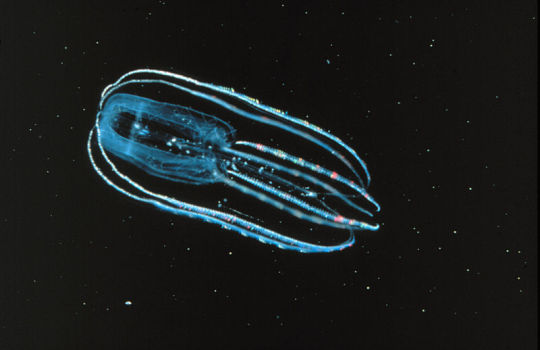
Ctenophore, Bolinopsis infundibulum
The “C” in ctenophore is silent, so when pronounced, the name sounds like 10 oh 4, which in the United States date system corresponds to October 4th. Consequently, October 4th is Ctenophore Day!
How to celebrate? Tasty fare could include gooseberries and walnuts, given that common names for ctenophores include sea gooseberry and sea walnut. Kiwi fruits are known as Chinese gooseberries (even though they are neither from China nor are they gooseberries), and they are in season in North America in October, so you could enjoy some kiwi fruit this Ctenophore Day!
Timothy A. Pearce, PhD, is the head of the mollusks section at Carnegie Museum of Natural History. Museum employees are encouraged to blog about their unique experiences and knowledge gained from working at the museum.
623 notes
·
View notes
Text
Extra information 2: Blood and oxidation states
The oxidation state of an atom is how many electrons it has lost or gained. If it has lost electrons it has a positive oxidation state and if the atom has gained electrons it has a negative oxidation state. When octopuses’ blood becomes oxygenated the copper atoms in haemocyanin loose an additional electron when they bond to oxygen changing the coppers oxidation state from +1 to +2. Compounds containing the same transitional metals in the same certain oxidation states usually have the same or similar colours for example copper compounds where copper has a +2 oxidation state are normally blue. So octopus blood is blue when oxygenated because the copper atoms in oxyhaemocyanin (oxygenated haemocyanin) have a +2 oxidation state.

The vanadium in haemovanadin found in sea squirts is almost always at a +3 oxidation state which is why it’s green as vanadium is usually green when in a +3 oxidation state. Iron in humans’ blood when oxygenated has a +3 oxidation state. Iron compounds in this oxidation state like some rust are usually anywhere from amber to red in colour.
Oxygen transporting proteins in animal’s blood are iron or copper based (haemovanadin does not reversibly bind with oxygen and so does not transport oxygen). There are other oxygen transporting proteins apart from haemoglobin and haemocyanin like haemerythrin and chlorocuorin. Haemerythrin is purple when oxygenated and colourless when deoxygenated. Haemerythrin is found in brachiopods (animals that look like bivalves except some are attached to the sea floor by fleshy stalks) and some phyla of marine worms called sipunculids and priapulids. Chlorocuorin is green both when oxygenated and deoxygenated and is present in many annelids (members of the phylum annelida that includes earthworms, leeches and polychaete worms). Haemerythrin and chlorocuorin are both iron based though.
Figure 2 & 3: Brachiopods
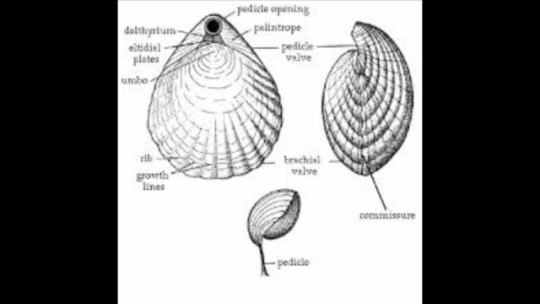


Despite oxygen transporting proteins in animals on Earth being limited to just copper and iron (as far as I’m aware) a cobalt based protein called coboglobin that reversably bonds to oxygen has been synthesized in the lab. Different sources contradict each other about it’s colour however some sites state it’s amber when oxygenated and clear when deoxygenated and some the other way round.
Animal like life on other planets or in alternative realities may have blood that contains proteins that contain transitional metals not found in animals blood on Earth. I drew the following drawings of hypothetical blood proteins because I thought they would look nice and not because I thought they would be good candidates for example chromium in a +6 oxidation state when bonded to other atoms (hexavalent chromium) is very toxic to humans and other animals. I have based the colours on the metals oxidation states typical colour.




25 notes
·
View notes
Photo

Kittenfish Genera
Kingdom: Animalia
Phylum: Chordata
Class: Sarcopterygii
Clade: Dipnomorpha
Subclass: Dipnoi
Order: Hemiamphibia
Family: Various (see below)
Ancestral species: Neoceratodus forsteri (Queensland lungfish)
Time period: early Lithocene to ? (65 million years to ? million years in the future [we have no idea how far into the future this genera survives because we have only gone to a maximum of 140 million years in the future]).
Information: the Kittenfish are a hardy genera of primarily-herbivorous and nocturnal fish. So hardy, in fact, that they have managed to survive two extinction-level events within a 30-million year span. Though they descend from lungfish, they have convergently evolved necks like their tetrapod cousins. Like their lungfish ancestors, they still have both lungs and gills, and can survive out of water for very long periods of time. Kittenfish have few teeth, and the only teeth they do have are small and rounded on the ends.
Shorttail Kittenfish (#1)
Kingdom: Animalia
Phylum: Chordata
Class: Sarcopterygii
Clade: Dipnomorpha
Subclass: Dipnoi
Order: Hemiamphibia
Family: Micropidae
Genus: Microps
Species: M. microcauda (”small-tailed small face”)
Ancestral species: Neoceratodus forsteri (Queensland lungfish)
Time period: late Lithocene to early Solocene (65 million years to 110 million years in the future).
Information: the Shorttail Kittenfish looks more like a dinosaur than a fish with its large sail and reptile-like head. This creature is about the size of a cleaner wrasse, and it feeds primarily on the bountiful algae and kelp around Occidensia’s beaches. They form large schools for safety when traveling in open water, though their small size and speed alone make them a hassle for any predator to try and catch, save for the dreaded Sea Albatross. It is also the earliest species of Kittenfish documented, with the earliest specimen found 65 million years in the future. The Shorttail Kittenfish is a dark green, perfect for blending in amongst its food source.
Longtail Kittenfish (#2)
Kingdom: Animalia
Phylum: Chordata
Class: Sarcopterygii
Clade: Dipnomorpha
Subclass: Dipnoi
Order: Hemiamphibia
Family: Micropidae
Genus: Microps
Species: M. macrocauda (”large-tailed small face”)
Ancestral species: Neoceratodus forsteri (Queensland lungfish)
Time period: early to late Solocene (105 million years to 135 million years in the future).
Information: a fast-moving nocturnal herbivore the size of a largemouth bass, the Longtail Kittenfish makes the kelp forests off the coast of Thalassia its home. They live under small rock crevices, but will also burrow themselves in the sand if necessary. It is a very-friendly animal to humans, showing no fear in approaching them. They also make good diving companions. It’s like a dog, but if it was a lungfish. And, if you ever need a quick food source, their meat tastes pretty-good (though, I’m not sure as to who would want to kill such an adorably puggish-looking animal). The Longtail Kittenfish is a bright yellow in color, which is perhaps a bit counterintuitive for avoiding predators.
Shellhead Kittenfish (#3)
Kingdom: Animalia
Phylum: Chordata
Class: Sarcopterygii
Clade: Dipnomorpha
Subclass: Dipnoi
Order: Hemiamphibia
Family: Ostracocephalidae
Genus: Ostracocephalus
Species: O. coelolophus (”hollow-crested shell-head)
Ancestral species: Neoceratodus forsteri (Queensland lungfish)
Time period: early Solocene (105 million years to 115 million years in the future).
Information: the Shellhead Kittenfish gets its name from the ossified fins on its head, which is uses as a means of communicating with one another. This animal is remarkable for both its size and coloration, being the largest member of the Kittenfish at a whopping 4 feet in length and its scales being an iridescent turquoise and its cephalic (head) fins being striped gold and green and having bright-red ovals in the middle. The oval shapes on the cephalic fins are bioluminescent, and the Shellhead Kittenfish can turn the glow on and off like a flashlight at its own free will. Like other Kittenfish, it is a nocturnal herbivore, and spends much of its time feeding on algae and aquatic plants around the Thalassian coast. It also makes a nice aquarium fish if you got a large-enough tank.
Flying Kittenfish (#4)
Kingdom: Animalia
Phylum: Chordata
Class: Sarcopterygii
Clade: Dipnomorpha
Subclass: Dipnoi
Order: Hemiamphibia
Family: Cyclocaudidae
Genus: Cyclocauda
Species: C. ichthyopteryx (”circle-tailed fish-wing”)
Ancestral species: Neoceratodus forsteri (Queensland lungfish)
Time period: late Nyctocene to early Solocene (95 million years to 107 million years in the future).
Information: filling the niche left by flying fishes, which died out approximately 2 million years before it, around 93 million years in the future, the Flying Kittenfish is a remarkable animal. The only member of its order that is capable of gliding, it lives across much of the world’s oceans, and feeds primarily on plankton and small crustaceans. They tend to form large schools in open ocean for safety. Also, they make a good food source. Just throwing that out there.
Reef Kittenfish (#5)
Kingdom: Animalia
Phylum: Chordata
Class: Sarcopterygii
Clade: Dipnomorpha
Subclass: Dipnoi
Order: Hemiamphibia
Family: Micropidae
Genus: Microps
Species: M. plesiominimus (”near-least small face”)
Ancestral species: Neoceratodus forsteri (Queensland lungfish)
Time period: early Solocene to ? (105 million years to ? million years in the future)
Information: living among the coral reefs off the coast of Thalassia, the Reef Kittenfish spends much of its eating algae off the coral. The size of a bluegill, the Reef Kittenfish is small, maneuverable, and fast. In coloration, it is violet. Hence, it also had the nickname of “the Violet Kittenfish”. They make small burrows in the sand, where they hide from predators. Overall, this animal is the hide-and-seek champion; it’s very difficult to spot once it’s buried in sand.
Dwarf Kittenfish (#6)
Kingdom: Animalia
Phylum: Chordata
Class: Sarcopterygii
Clade: Dipnomorpha
Subclass: Dipnoi
Order: Hemiamphibia
Family: Micropidae
Genus: Microps
Species: M. minimus (”least small-face”)
Ancestral species: Neoceratodus forsteri (Queensland lungfish)
Time period: late Nyctocene to early Solocene (95 million years to 110 million years in the future).
Information: at only the size of a minnow, the Dwarf Kittenfish is the smallest member of its order. Living in the coral reefs off the coast of Thalassia, the Dwarf Kittenfish shares a similar niche to its close relative, the Reef Kittenfish, in that it also eats algae off of coral. However, the Dwarf Kittenfish lives inside sea anemones, for which it has developed an immunity to their toxins. Its color is a vibrant pink.
5 notes
·
View notes